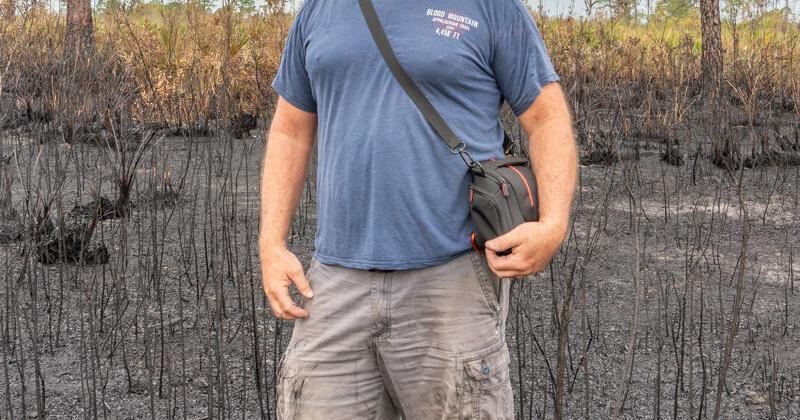EDITOR’S NOTE: The Highlands County landscape is truly captivating, with roadways meandering through prairies and winding around picturesque lakes. Extensive hiking trails traverse various natural areas, offering a plethora of sights to behold. So, lace up those hiking shoes, grab your keys, and embark on a journey to explore the wonders of Highlands County. (Kevin Main, a resident of Highlands County since 1979, shares his adventures in the wilderness through Kickin’ It With Kevin, guiding readers on explorations of wilderness trails, scenic driving routes, and more within Highlands County.)
It’s not the arrival of spring that excites me the most; rather, it’s the onset of fire season in Florida. Florida’s predisposition to fires is undeniable, attributed to its rapid vegetation growth, arid winters and springs, and frequent lightning strikes—a combination that has fueled fires in the region for millennia. The period from April to June marks the peak of fire activity in Florida.
Land managers overseeing conservation areas comprehend the seasonal nature of fires and endeavor to replicate the effects of natural lightning-induced fires by conducting controlled burns during this period. These controlled burns serve to eliminate dead vegetation, diminish the risk of uncontrollable wildfires, and enhance the habitat for Florida’s indigenous flora and fauna. With this in mind, I geared up in my hiking boots and set off for Carter Creek.
Carter Creek forms part of the expansive Lake Wales Ridge Wildlife and Environmental Area (LWRWEA) managed by the Florida Fish and Wildlife Conservation Commission. Among the various parcels of the LWRWEA, Carter Creek boasts a well-maintained hiking trail.
To access the trailhead, starting from the junction of MLK Jr. Boulevard and Arbuckle Creek Road (northeast of downtown Sebring), head east on Arbuckle Creek Road, then north on Riverdale Road, following the signs leading to the parking area. Arriving at the parking lot under the cover of darkness, the scent of smoke greeted me as I stepped out of the car. I was aware that the LWRWEA managers had recently conducted a controlled burn in the vicinity of the hiking trail, and I was eager to witness the aftermath of the fire.
The Marsh Trail at Carter Creek, spanning 2.5 miles, predominantly traces old paths and firebreaks, resulting in a sandy terrain. The trail encompasses a vast, open, seasonally flooded wetland area, offering sweeping panoramic views. The site is routinely subjected to controlled burns to preserve its natural state. At the time of my visit, only the eastern section had been burned. Setting off at daybreak, I remained hopeful for captivating photographic opportunities along the trail.
The charred landscape bore witness to the recent fire, with blackened remnants and scorched vegetation interspersed with pockets of untouched greenery—a common sight in regularly burned areas. The deliberate mosaic of burnt and unburnt patches was precisely what the managers had aimed for, a harmonious blend fostering ecological diversity.
Despite the post-fire rainfall, wisps of smoke lingered in certain areas, possibly emanating from smoldering stumps or logs. Managers meticulously plan controlled burns to mitigate smoke dispersion towards residential areas and roads, yet prolonged smoldering post-burn coupled with shifting wind patterns can pose challenges. The prospect of imminent rain post-burn is always welcomed by managers, as it aids in extinguishing lingering embers and minimizing smoke-related issues.
Continuing my trek, I traversed a section of the trail where one side had been recently burned, contrasting with the opposite side burned a year earlier. The resilience of Florida’s vegetation was evident, with rapid regrowth in the area burned the previous year, showcasing the vitality of root systems that endure for centuries. Amidst the charred remnants, new life emerged—a poignant testament to nature’s regenerative power.
As I concluded my hike and made my way back to the car, I passed by a weathered pine tree bearing a spiraling scar—a reminder of a past lightning strike. Unlike most strikes, this one did not ignite a fire, owing to the controlled burns that had mitigated the fuel load in the area. Despite succumbing to the strike, the aged tree would persist, providing a habitat for local wildlife in the years to come.
The words of John Muir, a revered conservationist, resonated in my mind: “Between every two pines is a doorway to a new world.” Muir’s advocacy laid the foundation for the conservation movement in the United States, culminating in the protection of lands like those along the Lake Wales Ridge. However, land acquisition is merely the initial step; effective management is paramount to safeguarding these precious resources. In Florida, fire plays a pivotal role in maintaining ecological balance, underscoring the symbiotic relationship between fire and life.
